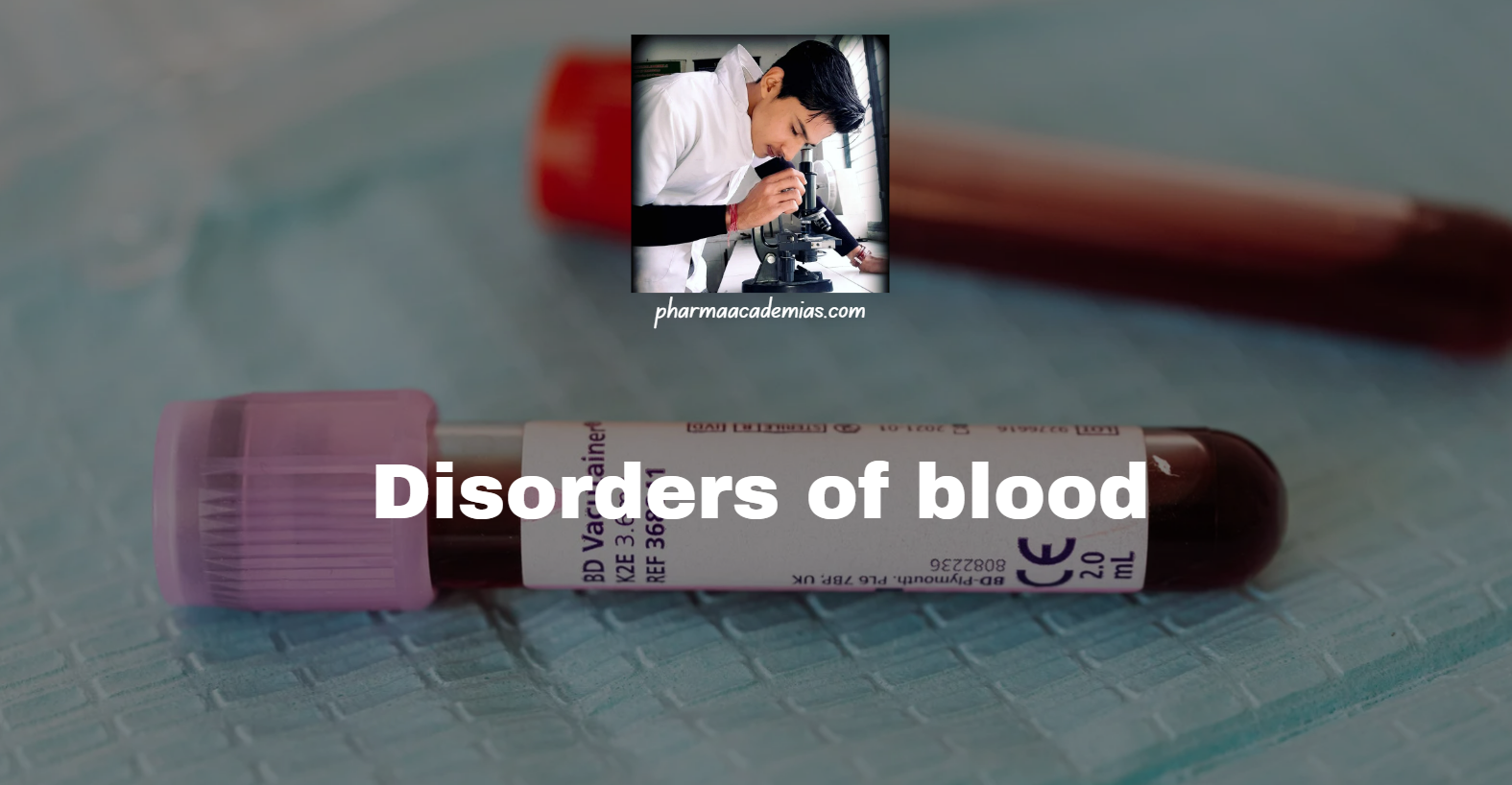Disorders of blood, also known as hematological disorders, encompass a wide range of medical conditions that affect the blood, its components, or the organs involved in blood production and regulation. These disorders can impact the red blood cells, white blood cells, platelets, plasma, or bone marrow. Some common blood disorders include:

Disorders of blood
1. Anemia
Anemia results from a deficiency in the number of red blood cells (RBCs) in the blood or a decrease in the amount of hemoglobin within these RBCs. Hemoglobin, a protein within RBCs, carries oxygen from the lungs to the body’s tissues and organs. When a person has anemia, their blood’s capacity to carry oxygen reduces, leading to various symptoms and potential health issues. These symptoms often include fatigue, weakness, paleness, shortness of breath, dizziness, and an irregular heartbeat. Anemia can have various underlying causes, such as nutritional deficiencies (e.g., iron, vitamin B12, folic acid), chronic diseases, genetic conditions, and more, and treatment depends on addressing the specific cause.
2. Hemophilia
Hemophilia is a rare, inherited bleeding disorder characterized by a deficiency or absence of specific clotting factors in the blood. This deficiency impairs the body’s ability to form blood clots, which can result in prolonged and spontaneous bleeding, both internally and externally, after injury or trauma. Hemophilia primarily affects males, and it is typically transmitted from parents to their children through a genetic mutation. The severity of hemophilia can vary, with some individuals experiencing mild symptoms and others facing more severe and life-threatening bleeding episodes. Treatment for hemophilia often involves clotting factor replacement therapy to enable normal blood clotting.
3. Leukemia
Leukemia is cancer that originates in the bone marrow, leading to the uncontrolled production of abnormal white blood cells, which can crowd out healthy cells and cause health problems. It can be classified by progression speed (acute or chronic) and white blood cell type (lymphocytes or myeloid cells). Treatment and prognosis depend on leukemia type and stage at diagnosis.
4. Thrombocytopenia
Thrombocytopenia is a result of a lower-than-normal platelet count, which impairs the blood’s ability to clot. Platelets, or thrombocytes, play a crucial role in clotting and wound healing. Various underlying causes, including medical conditions, medications, infections, and autoimmune disorders, can lead to thrombocytopenia. Its severity varies, with mild cases often requiring no treatment, while more severe cases may necessitate medical intervention to raise platelet levels and prevent bleeding complications.
5. Sickle Cell Disease
Sickle cell disease (SCD) is a genetic blood disorder characterized by the presence of abnormal hemoglobin, a protein in red blood cells that carries oxygen throughout the body. In individuals with SCD, a genetic mutation causes hemoglobin to form a different shape when oxygen levels are low, leading to the production of rigid and misshapen red blood cells known as “sickle cells.” These irregularly shaped cells can block blood vessels, impede blood flow, and cause various complications, including pain, organ damage, and an increased risk of infections. Sickle cell disease is a lifelong condition that can result in chronic health issues, and its severity varies among individuals. Treatment and management focus on alleviating symptoms, preventing complications, and improving the patient’s overall quality of life.
6. Lymphoma
Lymphoma starts in the lymphatic system, impacting lymphocytes, white blood cells that defend against infections. Abnormal lymphocyte growth leads to tumor formation in the lymphatic system, including lymph nodes, spleen, bone marrow, and other tissues. It’s categorized as Hodgkin lymphoma (HL) or non-Hodgkin lymphoma (NHL), with subtypes in the latter. Symptoms, prognosis, and treatment depend on lymphoma type and stage.
7. Polycythemia vera
Polycythemia vera (PV) is a rare, chronic blood disorder that falls under the category of myeloproliferative neoplasms (MPNs). PV is characterized by the overproduction of red blood cells, white blood cells, and platelets in the bone marrow. This excessive production of blood cells results in the thickening of the blood and an increased risk of blood clots, which can lead to various health complications. Polycythemia vera is a clonal disorder, meaning it arises from a mutation in a single hematopoietic stem cell.
8. Myelodysplastic Syndromes (MDS)
Myelodysplastic syndromes (MDS) result from the abnormal and dysfunctional production of blood cells in the bone marrow. In MDS, the bone marrow fails to produce an adequate number of healthy blood cells, including red blood cells, white blood cells, and platelets. This leads to low blood cell counts in individuals with MDS, causing a range of symptoms and complications. MDS is considered a type of myeloproliferative neoplasm (MPN) and can sometimes progress to acute myeloid leukemia (AML).
9. Aplastic Anemia
Aplastic anemia is a rare and serious blood disorder characterized by a significant decrease in the number of all three major types of blood cells: red blood cells, white blood cells, and platelets. This condition occurs when the bone marrow, which is responsible for producing these blood cells, fails to function properly. Aplastic anemia can result in anemia, a weakened immune system, and a heightened risk of bleeding or infection due to low blood cell counts.
10. Coagulation Disorders
Abnormalities in the blood’s ability to clot properly result in coagulation disorders, also known as bleeding disorders. In individuals with coagulation disorders, this process can be impaired, leading to a tendency to bleed excessively or for prolonged periods even with minor injuries, despite blood clotting, or coagulation, being a vital process that helps control bleeding when blood vessels are injured.

